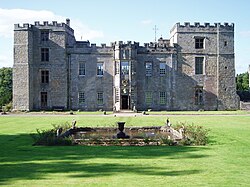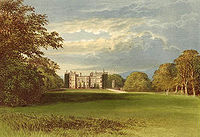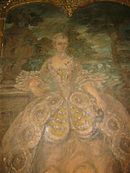Difference between revisions of "Chillingham Castle"
(Created page with "{{Infobox castle |name=Chillingham Castle |county=Northumberland |picture=Chillingham_Castle.jpg |picture caption=Chillingham Castle |os grid ref=NU060257 |latitude=55.526 |lo...") |
m |
||
| (One intermediate revision by one other user not shown) | |||
| Line 15: | Line 15: | ||
'''Chillingham Castle''' is a mediæval castle in the village of [[Chillingham, Northumberland|Chillingham]] in the northern part of [[Northumberland]]. It was the seat of the Grey (Baron Grey of Werke) and Bennet (Earls of Tankerville) families from the 15th century until the 1980s. | '''Chillingham Castle''' is a mediæval castle in the village of [[Chillingham, Northumberland|Chillingham]] in the northern part of [[Northumberland]]. It was the seat of the Grey (Baron Grey of Werke) and Bennet (Earls of Tankerville) families from the 15th century until the 1980s. | ||
| − | A large enclosed park on the castle grounds is home to the Chillingham Cattle, an ancient, rare breed, consisting of about 90 head of cattle living as feral beasts.<ref>BBC Countryfile, 1 November 2009</ref> The castle is a Grade | + | A large enclosed park on the castle grounds is home to the Chillingham Cattle, an ancient, rare breed, consisting of about 90 head of cattle living as feral beasts.<ref>BBC Countryfile, 1 November 2009</ref> The castle is a Grade-I listed building.<ref>{{NHLE|1042387|Chillingham Castle}}</ref> |
==History== | ==History== | ||
| Line 31: | Line 31: | ||
In the 18th and 19th century the grounds underwent landscaping, including work carried out by Sir Jeffry Wyattville. | In the 18th and 19th century the grounds underwent landscaping, including work carried out by Sir Jeffry Wyattville. | ||
| − | The once extensive park, now under a separate ownership from the castle, is home to the famous Chillingham Wild Cattle.<ref name=autogenerated1> | + | The once extensive park, now under a separate ownership from the castle, is home to the famous Chillingham Wild Cattle.<ref name=autogenerated1>[http://www.telegraph.co.uk/travel/734150/Britain-As-if-to-the-manor-born-part-2.html The Daily Telegraph (Fiona Duncan) 'Britain: As if to the manor born (part 2)], 7 December 2005</ref> |
During the Second World War, the castle was used as an army barracks. During this time, much of the decorative wood is said to have been stripped out and burned by the soldiers billeted there. After the war, the castle began to fall into disrepair. Lead had been removed from the roof, resulting in extensive weather damage to large parts of the building. In 1982, the castle was purchased by Sir Humphry Wakefield, 2nd Baronet, whose wife Catherine is descended from the Greys of Chillingham, and Wakefield set about a painstaking restoration of the castle. Sections of the castle are open to the public, and holiday apartments are available for hire.<ref name=autogenerated1 /> | During the Second World War, the castle was used as an army barracks. During this time, much of the decorative wood is said to have been stripped out and burned by the soldiers billeted there. After the war, the castle began to fall into disrepair. Lead had been removed from the roof, resulting in extensive weather damage to large parts of the building. In 1982, the castle was purchased by Sir Humphry Wakefield, 2nd Baronet, whose wife Catherine is descended from the Greys of Chillingham, and Wakefield set about a painstaking restoration of the castle. Sections of the castle are open to the public, and holiday apartments are available for hire.<ref name=autogenerated1 /> | ||
| Line 44: | Line 44: | ||
In the novel ''The Bride of Lammermoor'' (1819) by Sir Walter Scott, Chillingham Castle is singled out as a last refuge for an ancient breed of Scottish cattle. | In the novel ''The Bride of Lammermoor'' (1819) by Sir Walter Scott, Chillingham Castle is singled out as a last refuge for an ancient breed of Scottish cattle. | ||
| − | The castle and cattle served as inspiration for Eva Ibbotson's 2005 children's book, ''The Beasts of Clawstone Castle''.<ref name="Journal">{{cite news |last=Whetstone |first=David |date=17 May 2005 |title=Eva just gets better |url=http://www.thejournal.co.uk/culture/theatre/eva-just-gets-better-4617576 |newspaper=The Journal |location=Newcastle Upon Tyne | | + | The castle and cattle served as inspiration for Eva Ibbotson's 2005 children's book, ''The Beasts of Clawstone Castle''.<ref name="Journal">{{cite news |last=Whetstone |first=David |date=17 May 2005 |title=Eva just gets better |url=http://www.thejournal.co.uk/culture/theatre/eva-just-gets-better-4617576 |newspaper=The Journal |location=Newcastle Upon Tyne |accessdate=15 February 2015}}</ref><ref name="Scotsman">{{cite news |author=<!--Staff writer(s); no by-line.--> |title=Obituary: Eva Ibbotson |url=http://www.scotsman.com/news/obituaries/obituary-eva-ibbotson-writer-1-826121 |newspaper=The Scotsman |location=Edinburgh |date=25 October 2010 |accessdate=15 February 2015}}</ref> |
==Outside links== | ==Outside links== | ||
Latest revision as of 15:39, 8 September 2018
| Chillingham Castle | |
|
Northumberland | |
|---|---|
 Chillingham Castle | |
| Location | |
| Grid reference: | NU060257 |
| Location: | 55°31’34"N, 1°54’18"W |
| History | |
| Information | |
| Owned by: | Sir Humphry Wakefield |
Chillingham Castle is a mediæval castle in the village of Chillingham in the northern part of Northumberland. It was the seat of the Grey (Baron Grey of Werke) and Bennet (Earls of Tankerville) families from the 15th century until the 1980s.
A large enclosed park on the castle grounds is home to the Chillingham Cattle, an ancient, rare breed, consisting of about 90 head of cattle living as feral beasts.[1] The castle is a Grade-I listed building.[2]
Contents
History
Middle Ages
The castle was originally a monastery in the late 12th century. In 1298, King Edward I stayed at the castle on his way to Scotland to battle a Scottish army led by William Wallace. A glazed window in a frame was specially installed for the king, a rarity in such buildings at the time. The Chillingham Wild Cattle occupy land adjacent to the castle, formerly owned by the Sir John Knott Trust, now owned by the Chillingham Wild Cattle Association (a charity not associated with the castle).
The castle occupied a strategically important location in the Middle Ages: it was located on the border between two feuding nations. It was used as a staging post for English armies entering Scotland, but was also repeatedly attacked and besieged by Scottish armies and raiding parties heading south. The site contained a moat, and in some locations the fortifications were twelve feet thick.
The building underwent a harsh series of enhancements, and in 1344 a Licence to crenellate was issued by King Edward III to allow battlements to be built, effectively upgrading the stronghold to a fully fortified castle, of quadrangular form.
Modern era
In 1617, King James I stayed at the castle on a journey between his two kingdoms. As relations between the two countries became peaceful following the union of the crowns, the need for a military stronghold in the area declined. The castle was gradually transformed; the moat was filled, and battlements were converted into residential wings. A banquet hall and a library were built.
In the 18th and 19th century the grounds underwent landscaping, including work carried out by Sir Jeffry Wyattville.
The once extensive park, now under a separate ownership from the castle, is home to the famous Chillingham Wild Cattle.[3]
During the Second World War, the castle was used as an army barracks. During this time, much of the decorative wood is said to have been stripped out and burned by the soldiers billeted there. After the war, the castle began to fall into disrepair. Lead had been removed from the roof, resulting in extensive weather damage to large parts of the building. In 1982, the castle was purchased by Sir Humphry Wakefield, 2nd Baronet, whose wife Catherine is descended from the Greys of Chillingham, and Wakefield set about a painstaking restoration of the castle. Sections of the castle are open to the public, and holiday apartments are available for hire.[3]
Chillingham's ghosts
Its current owners market the castle as being the most haunted castle in Britain.[4][5] It has been investigated on television and radio (for example, Most Haunted,[6] I'm Famous and Frightened!, Scariest Places On Earth, Holiday Showdown, Alan Robson's Nightowls), Ghost Hunters International, and is the subject and setting of the documentary, A Blood Red Sky (2013). Some of these ghosts are written about are referred to in a 1925 pamphlet by Leonora, Countess of Tankerville. Others, such as John Sage, are of more recent invention.
The most famous ghost of the castle is the "blue (or radiant) boy", who according to the owners used to haunt the Pink Room in the castle.[7] Guests supposedly reported seeing blue flashes and a blue "halo" of light above their beds after a loud wail. It is claimed that the hauntings ceased after renovation work revealed a man and a young boy inside a 10-foot-thick wall. Documents dating back to the Spanish Armada were also found within the wall.
In literature
In the novel The Bride of Lammermoor (1819) by Sir Walter Scott, Chillingham Castle is singled out as a last refuge for an ancient breed of Scottish cattle.
The castle and cattle served as inspiration for Eva Ibbotson's 2005 children's book, The Beasts of Clawstone Castle.[8][9]
Outside links
| ("Wikimedia Commons" has material about Chillingham Castle) |
References
- ↑ BBC Countryfile, 1 November 2009
- ↑ National Heritage List 1042387: Chillingham Castle
- ↑ 3.0 3.1 The Daily Telegraph (Fiona Duncan) 'Britain: As if to the manor born (part 2), 7 December 2005
- ↑ Chillingham Castle
- ↑ The ghosts of a chance - Telegraph
- ↑ Castle's ghostly reputation leads to expansion plans - Local Headlines - Berwick Advertiser
- ↑ Northumberland: Castle's knight in shining armour - Telegraph
- ↑ Whetstone, David (17 May 2005). "Eva just gets better". The Journal (Newcastle Upon Tyne). http://www.thejournal.co.uk/culture/theatre/eva-just-gets-better-4617576. Retrieved 15 February 2015.
- ↑ "Obituary: Eva Ibbotson". The Scotsman (Edinburgh). 25 October 2010. http://www.scotsman.com/news/obituaries/obituary-eva-ibbotson-writer-1-826121. Retrieved 15 February 2015.

